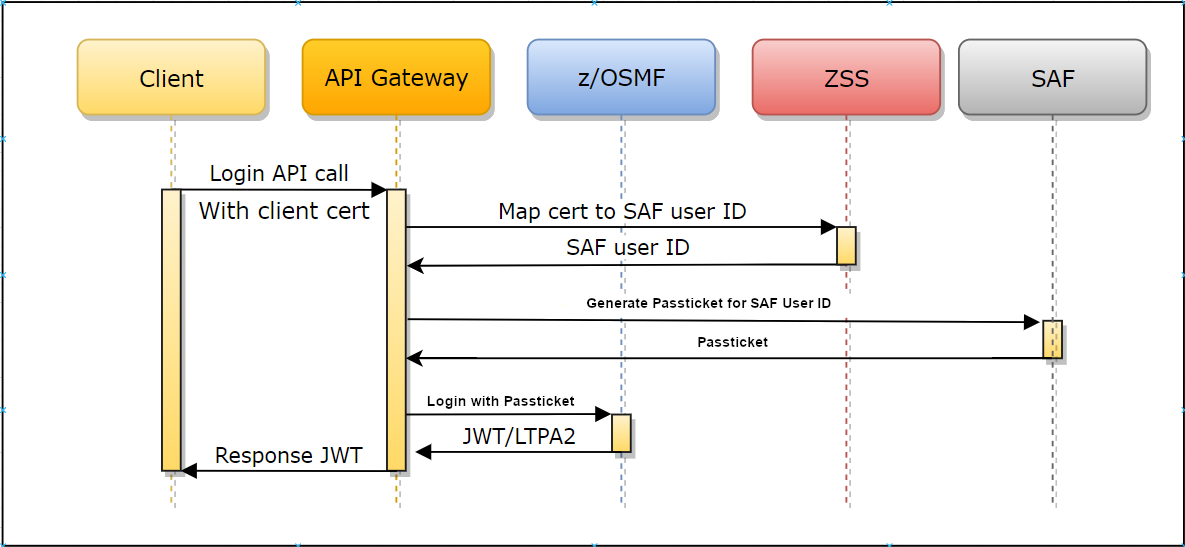Authenticating with client certificates
Authenticating with client certificates
Authentication for integration with API Mediation Layer (API ML) can also be performed by the client when the service endpoint is called through the API ML Gateway with client certificates. Client certification must be enabled and configured. For details about this configuration, see Enabling single sign on for clients via client certificate configuration.
-
When calling the login endpoint with basic authentication credentials, as well as with client certificate, the basic authentication credentials take precedence and the client certificate is ignored.
-
If you are calling a specific endpoint on one of the onboarded services, API Mediation Layer ignores Basic authentication. In this case, the Basic authentication is not part of the authenticated request.
How the Gateway resolves authentication
When sending a request to a service with a client certificate, the Gateway performs the following process to resolve authentication:
- The client calls the service endpoint through the API ML Gateway with the client certificate.
- The client certificate is verified as a valid TLS client certificate against the trusted certificate authorities (CAs) of the Gateway.
- The public key of the provided client certificate is verified against SAF. SAF subsequently returns a user ID that owns this certificate. As of Zowe version 2.14, the API for API ML can be provided by the internal API ML mapper if the mapper is enabled. Alternatively, you can use Z Secure Services (ZSS) to provide this API for API ML, although we recommend using the internal API ML mapper.
- The Gateway then performs the login of the mapped user and provides valid authentication to the downstream service.
- Currently, ZSS is the default API that provides this mapping between the public part of the client certificate and SAF user ID. However, the recommended method is to use the internal API ML mapper. For information about the enabling the internal API ML mapper, see Configure Internal API ML Mapper in the article Enabling single sign on for clients via client certificate configuration.
- For information about ZSS, see the section Zowe runtime in the Zowe server-side installation overview.
When sending a request to the login endpoint with a client certificate, the Gateway performs the following process to exchange the client certificate for an authentication token:
- The client calls the API ML Gateway login endpoint with the client certificate.
- The client certificate is verified to ensure this is a valid TLS client certificate against the trusted CAs of the Gateway.
- The public part of the provided client certificate is verified against SAF. SAF subsequently returns a user ID that owns this certificate. As of Zowe release 2.14, the internal API ML mapper can provide this API for API ML if enabled in the zowe.yaml file. Alternatively, ZSS can provide this API for API ML, with the noted exception when using ACF2.
- The Gateway then performs the login of the mapped user and returns a valid JWT token.
ZSS is currently the default API that provides this mapping between the public part of the client certificate and SAF user ID. Using the internal API ML mapper is, however, the recommended method.
The following diagram shows how routing works with ZSS.

For more information, see the Medium blog post Zowe client certificate authentication.
Configure your z/OS system to support client certificate authentication for a specific user
Register the client certificate with the user ID in your ESM. The following commands apply to both the internal API ML mapper and ZSS.
RACF
Click here for command details for RACF.
RACDCERT ADD(<dataset>) ID(<userid>) WITHLABEL('<label>') TRUST
SETROPTS RACLIST(DIGTCERT, DIGTRING) REFRESH
Alternatively, if you are using the internal API ML mapper, you can use the following command:
RACDCERT ID(<userid>) MAP
SDNFILTER('<subject's-distinguished-name-filter>')
WITHLABEL('<label>')
Note: The RACDCERT MAP command allows mapping a certificate to a user without adding the X.509 certificate to the ESM database. While this approach is more convenient, it could be considered less secure than adding the certificate to the ACID, which offers better control and protection.
ACF2
Click here for command details for ACF2.
INSERT <userid>.<certname> DSNAME('<dataset>') LABEL(<label>) TRUST
Alternatively, if you are using the internal API ML mapper, you can use the following command:
CERTMAP.<recid>
SDNFILTR(<subject's-distinguished-name-filter>)
LABEL(<label>)
USERID(<userid>)
TRUST
Top Secret
Click here for command details for Top Secret.
TSS ADDTO(<userid>) DIGICERT(<certname>) LABLCERT('<label>') DCDSN('<dataset>') TRUST
Alternatively, in case you are using the internal API ML mapper, you can use the following command:
TSS ADDT0(<userid>) CERTMAP(<recid>)
SDNFILTR('<subject's-distinguished-name-filter>')
USERID(<userid>)
TRUST
Additional details are likely described in your security system documentation.
- The alternative ESM map commands allow mapping a certificate to a user without adding the X.509 certificate to the ESM database. While this approach is more convenient, it could be considered less secure than adding the certificate to the ACID, which offers better control and protection.
- Ensure that you have the Issuer certificate imported in the truststore or in the SAF keyring. Alternatively, you can generate these certificates in SAF.
- Ensure that the client certificate has the following
Extended Key Usagemetadata:
OID: 1.3.6.1.5.5.7.3.2
This metadata can be used for TLS client authentication.
Validate the client certificate functionality
To validate that the client certificate functionality works properly, call the login endpoint with the certificate that was set up using the steps in Configure your z/OS system to support client certificate authentication for a specific user described previously in this article.
Validate using CURL, a command line utility that runs on Linux based systems:
Example:
curl --cert /path/to/cert.pem --key /path/to/key.pem https://api-mediation-layer:7554/gateway/api/v1/login
Your Zowe instance is configured to accept x.509 client certificates authentication.